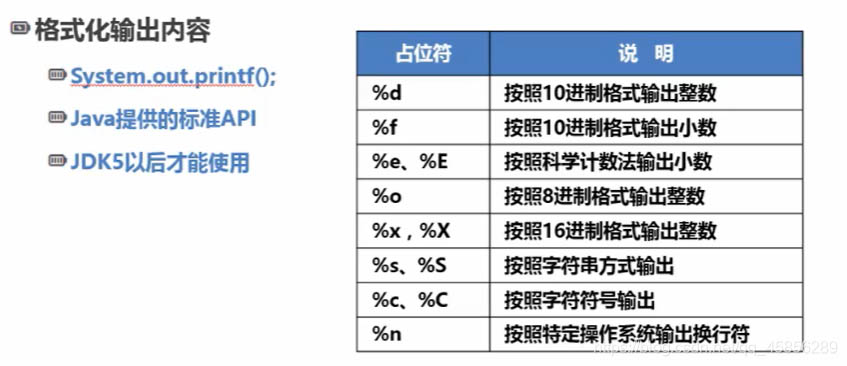兩種基本的輸入方式
1.使用Scanner類
需要java.util包
構(gòu)造Scanner類的對象,附屬于標(biāo)準(zhǔn)輸入流System.in,之后通過其中的方法獲得輸入。
常用的方法:nextLine();(字符串),nextInt();(整型數(shù)),nextDouble();(雙精度型數(shù))等等。
結(jié)束時使用close();方法關(guān)閉對象。
例子:
import java.util.*;
?
class IOTest {
?? ?public static void main(String args[]) {
?? ??? ?Scanner sc = new Scanner(System.in);
?? ??? ?System.out.println("enter your name:");
?? ??? ?String name = sc.nextLine();
?? ??? ?System.out.println("enter your age:");
?? ??? ?int age = sc.nextInt();
?? ??? ?System.out.println("enter your occupation:");
?? ??? ?String occ = sc.next();
?? ??? ?System.out.println("name:" + name + "\n" + "age:" + age + "\n" + "occupation:" + occ);
?? ??? ?sc.close();
?? ?}
}輸入:
enter your name:
g28
enter your age:
20
enter your occupation:
student
輸出:
name:g28
age:20
occupation:student
2.使用System.in.read();方法
需要java.io包。
System.in從標(biāo)注輸入獲取數(shù)據(jù),數(shù)據(jù)類型為InputStream。通過read();方法返回ASCII碼,若返回值為-1,說明沒有讀取到任何字符結(jié)束工作。
使用時需要添加拋出聲明或用try/catch包圍。
例子:
import java.io.*;
class IOTest {
?? ?public static void main(String args[]) {
?? ??? ?int c;
?? ??? ?System.out.println("please enter the string:");
?? ??? ?try {
?? ??? ??? ?while((c = System.in.read()) != -1)
?? ??? ??? ??? ?{
?? ??? ??? ??? ??? ?System.out.print((char)c);?
?? ??? ??? ??? ?}
?? ??? ?} catch (IOException e) {
?? ??? ??? ?System.out.println(e.toString());
?? ??? ?}
?? ?}
}輸入:
please enter the string:
My name is g28.
輸出:
My name is g28.
輸入與輸出的使用講解
1.輸入
Java的輸入,我們用到Scanner類,可以用它創(chuàng)建一個對象
Scanner input = new Scanner(System.in);然后input對象調(diào)用nextBoolean(),nextByte(),nextShort(),nextInt(),nextLong(),nextFloat(),nextDouble()方法來從輸入流中獲取數(shù)據(jù)。
package com.company; // 包
import java.util.Scanner;
public class code {
public static void main(String[] args){
// 掃描對象,用來掃描系統(tǒng)的輸入
Scanner input = new Scanner(System.in);
int a = input.nextInt(); // 輸入一個整型
short b = input.nextShort(); // 輸入一個短整型
long c = input.nextLong(); // 輸入一個長整型
byte d = input.nextByte(); // 輸入一個字節(jié)型
float f = input.nextFloat(); // 輸入一個單精度浮點(diǎn)型
double g = input.nextDouble(); // 輸入一個雙精度浮點(diǎn)型
// 輸入字符串
// nextLine() 和 next()都可以錄入String型的,但是next()遇到空格就終止了,nextLine()可以把空格和空格后面的全部錄入
String s = input.nextLine(); // 錄入一行,回車是終止符
String ss = input.next(); // 遇到空格或回車都會終止·
// 輸入一個char類型
// 獲得用戶輸入字符串的第一個字符
char ch = input.next().charAt(0);
}
}
?多組輸入:
import java.util.Scanner;
public class Mian {
public static void main(String[] args) {
Scanner cin = new Scanner(System.in); // cin是自己定義的,這個是任意的
while (cin.hasNext()) {
int a = cin.nextInt();
int b = cin.nextInt();
System.out.println(a + b);
}
}
}
?T組輸入:
// 使用while循環(huán)
import java.util.Scanner;
public class Mian {
public static void main(String[] args) {
Scanner cin = new Scanner(System.in); // cin是自己定義的,這個是任意的
int T = cin.nextInt();
while (T>0) {
int a = cin.nextInt();
int b = cin.nextInt();
System.out.println(a + b);
T--;
}
}
}
// 使用for循環(huán)
import java.util.Scanner;
public class Mian {
public static void main(String[] args) {
Scanner cin = new Scanner(System.in); // cin是自己定義的,這個是任意的
int T = cin.nextInt();
for(int i=0;i<T;i++)
{
int a = cin.nextInt();
int b = cin.nextInt();
System.out.println(a + b);
}
}
}
2.輸出
2.1.1 println直接輸出
使用語句System.out.println()輸出,System.out.println()為輸出并換行。
package com.company;
public class code {
public static void main(String[] args){
System.out.println("Hello World");
}
}
2.1.2 println輸出變量
package com.company;
public class code {
public static void main(String[] args){
int num = 10;
System.out.println("num的值為:" + num);
}
}
輸入num的值并且輸出
package com.company;
import java.util.Scanner;
public class code {
public static void main(String[] args){
Scanner input = new Scanner(System.in);
int num = input.nextInt();
System.out.println("num的值為:" + num);
}
}
2.2.1 print
使用語句System.out.print()輸出,System.out.print()為輸出但是不會換行,如果想要換行需要\n。print()與println()的作用類似,都是輸出,但唯一不同的是print()不會換行。
2.2.2 printf
jdk1.5新增了和C語言中printf函數(shù)類似的數(shù)據(jù)輸出方法,
System.out.printf(“格式控制部分”,表達(dá)式1,表達(dá)式2,……,表達(dá)式n);
這里的用法與C語言和C++中的類似
package com.company;
import java.util.Scanner;
public class code {
public static void main(String[] args){
Scanner input = new Scanner(System.in);
int num = input.nextInt();
System.out.printf("num的值為:%d\n" , num);
}
}
3.輸入輸出實例

package com.company;
import java.util.Scanner;
public class code {
public static void main(String[] args){
Scanner input = new Scanner(System.in);
// 輸入圓的半徑
double radius = input.nextDouble();
// 計算圓的面積
double area = 3.14 * radius * radius;
// 輸出圓的面積,保留兩位小數(shù)
System.out.printf("%.2f\n",area); // 注意:在Java中double類型用%f輸出(與C語言中的不同)
}
}
以上為個人經(jīng)驗,希望能給大家一個參考,也希望大家多多支持html5模板網(wǎng)。
